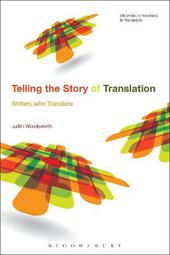
|
Telling the Story of Translation: Writers who Translate
Paperback / softback
Main Details
| Title |
Telling the Story of Translation: Writers who Translate
|
| Authors and Contributors |
By (author) Professor Judith Woodsworth
|
| Series | Bloomsbury Advances in Translation |
|---|
| Physical Properties |
| Format:Paperback / softback | | Pages:248 | | Dimensions(mm): Height 234,Width 156 |
|
| Category/Genre | Literary studies - general |
|---|
| ISBN/Barcode |
9781350101036
|
| Classifications | Dewey:418.04 |
|---|
| Audience | | Tertiary Education (US: College) | |
|---|
|
Publishing Details |
| Publisher |
Bloomsbury Publishing PLC
|
| Imprint |
Bloomsbury Academic
|
| Publication Date |
21 February 2019 |
| Publication Country |
United Kingdom
|
Description
Scholars have long highlighted the links between translating and (re)writing, increasingly blurring the line between translations and so-called 'original' works. Less emphasis has been placed on the work of writers who translate, and the ways in which they conceptualize, or even fictionalize, the task of translation. This book fills that gap and thus will be of interest to scholars in linguistics, translation studies and literary studies. Scrutinizing translation through a new lens, Judith Woodsworth reveals the sometimes problematic relations between author and translator, along with the evolution of the translator's voice and visibility. The book investigates the uses (and abuses) of translation at the hands of George Bernard Shaw, Gertrude Stein and Paul Auster, prominent writers who bring into play assorted fictions as they tell their stories of translations. Each case is interesting in itself because of the new material analysed and the conclusions reached. Translation is seen not only as an exercise and fruitful starting point, it is also a way of paying tribute, repaying a debt and cementing a friendship. Taken together, the case studies point the way to a teleology of translation and raise the question: what is translation for? Shaw, Stein and Auster adopt an authorial posture that distinguishes them from other translators. They stretch the boundaries of the translation proper, their words spilling over into the liminal space of the text; in some cases they hijack the act of translation to serve their own ends. Through their tales of loss, counterfeit and hard labour, they cast an occasionally bleak glance at what it means to be a translator. Yet they also pay homage to translation and provide fresh insights that continue to manifest themselves in current works of literature. By engaging with translation as a literary act in its own right, these eminent writers confer greater prestige on what has traditionally been viewed as a subservient art.
Author Biography
Judith Woodsworth is Professor of Translation Studies in the Department of French Studies at Concordia University, Canada.
Reviews[The book] sheds new light onto a less-researched part of the literary career of three "literary decathletes" as she [Woodsworth] calls Shaw, Stein and Auster ... Therefore, it is useful not only to students and researchers in the field of Translation Studies, but also to those interested in literary and cultural studies. * LINGUIST List * Something of a prophet in Canada, Woodsworth (French studies, Concordia Univ., Montreal) offers here a tripartite explication of translation strategies principally by three prominent authors: George Bernard Shaw, Gertrude Stein, and Paul Auster. En passant, Woodsworth exposes the complex lives and extensive bibliographies of the three writers to yield insights into their acts of translation and interpretation. Explored are links between translating and (re)writing by these eminent authors who translate and how they conceptualized or even fictionalized the task of translation. The evolution of the translator's voice and visibility is also scrutinized. Woodsworth's case studies illuminate a teleology of translation, insofar as the process may pay tribute, repay a debt, or cement a friendship. Bleak tales of loss, counterfeit, or hard labor may yet also complement with fresh perceptions, allowing translation, finally, to be taken not as a subservient art but as a literary act in its own right. Woodsworth's epilogue steps along further with discussion of three genre-bending and multidimensional storytellers: Jonathan Safran Foer, Rachel Cantor, and Idra Novey. Including extensive notes, this volume will be extremely useful for scholars in linguistics and translation studies. Summing Up: Highly recommended. Upper-division undergraduates through faculty. * CHOICE *
|